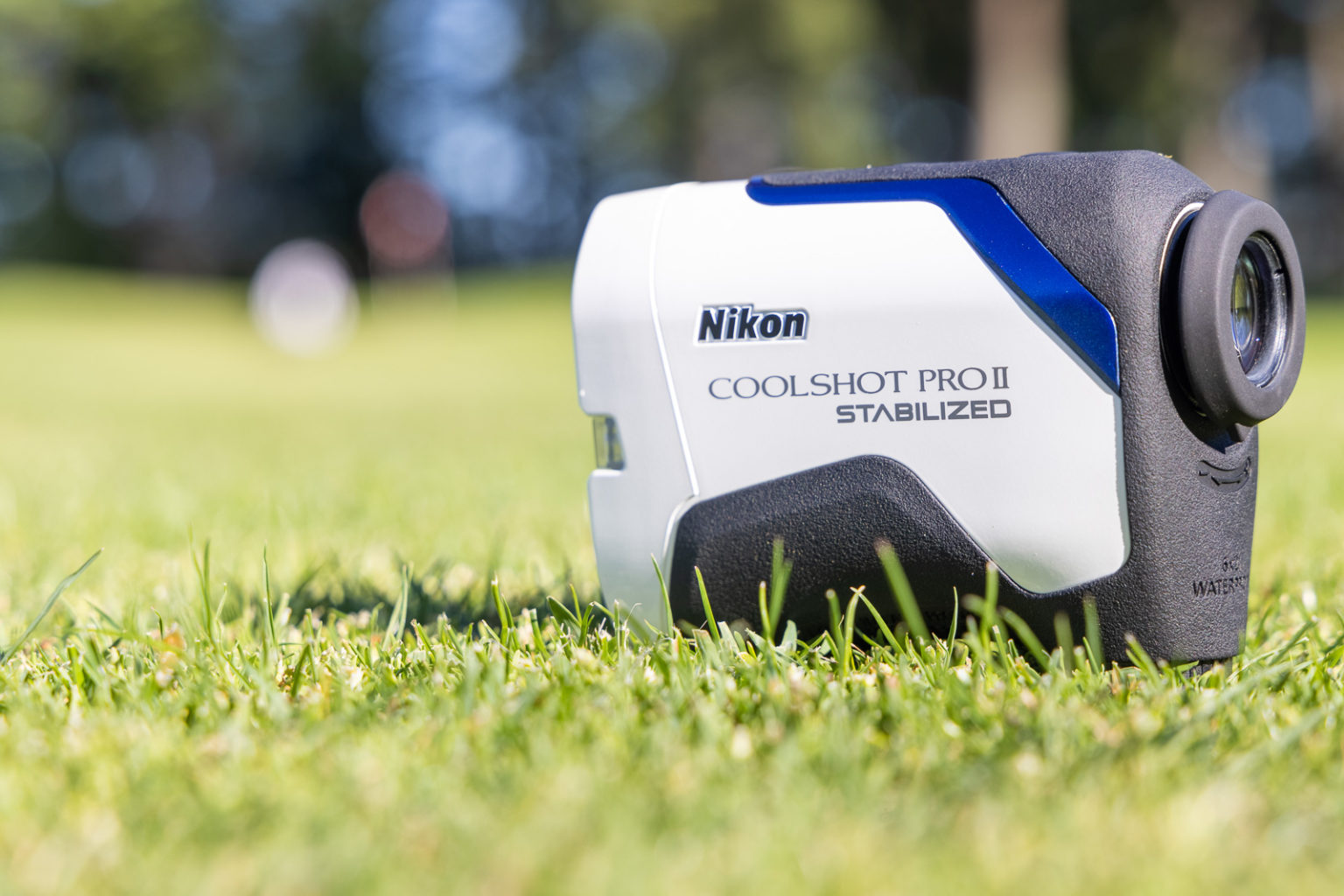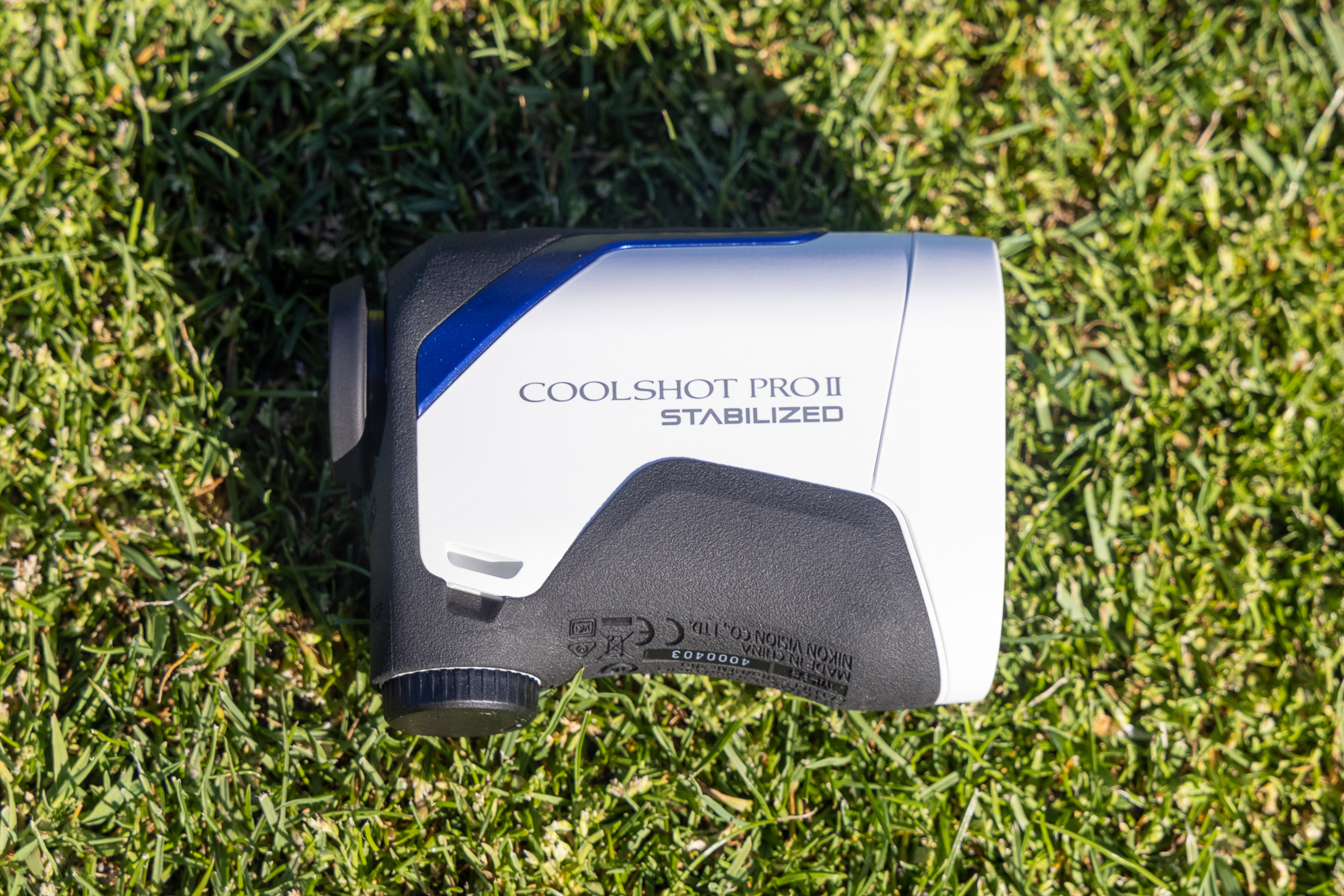This Nikon Coolshot Pro II Stabilized review was updated in August 2023 to provide long term feedback, update pricing, and compare to the most recent golf rangefinders on the market.
Honestly, I’ve reviewed a ton of rangefinders on this site, and when it comes to top-of-the-line rangefinders, it’s been all Bushnell.
Precision Pro has been making headway, but when it comes to the best of the best in terms of optics and ease of use, Bushnell is king.
That said, it seems Nikon may have something to say about that.
Yeah, that Nikon. The one that makes cameras.
I recently got my hands on the Nikon Coolshot ProII Stabilized (now that’s a name) golf rangefinder, and had some very high hopes leading into my first round with it.
You see, where most of the other rangefinder brands fail is in optic quality.
You can pack all the features you want into a rangefinder, but if it’s blurry or the screen isn’t sharp – it’s not going to be enjoyable to use.
When it comes to high-quality optics, Nikon is one of the very best in the business. Nearly every photo for the first 6 years of this site was shot with a Nikon camera.
Needless to say, I’ve been excited to get this out on the course and see what it can do.
With this review, I’ll be directly comparing the Nikon Coolshot ProII Stabilized to the Bushnell Pro XE and the Bushnell V5 with Slope. This Coolshot sits right in the middle of those price-wise, so these are logical competitors.
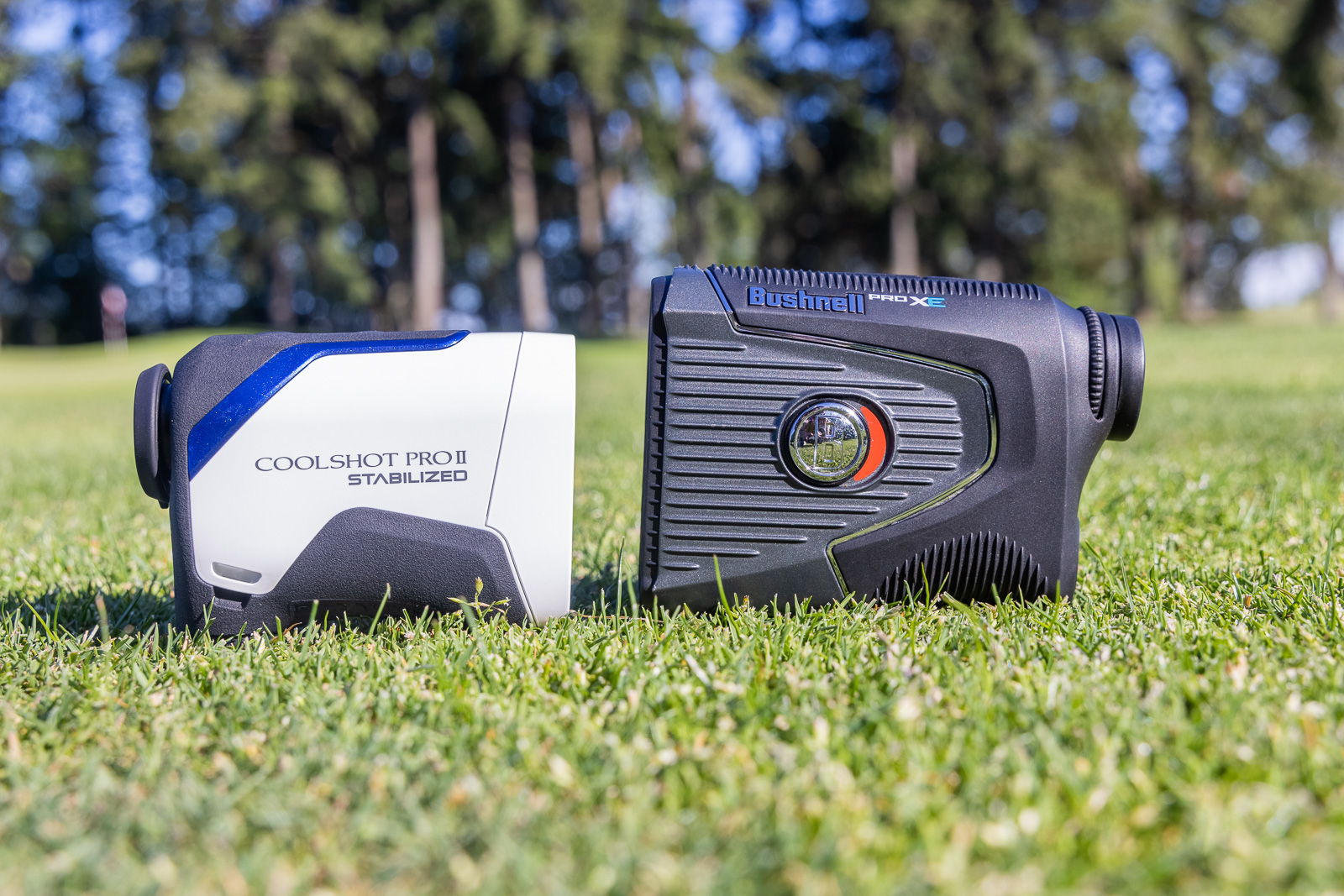
I’ll also talk about the Nikon Coolshot 50i, which I’ve also used and will be reviewing separately soon.
Ready to find out if Nikon can dethrone Bushnell as king of the rangefinders?
Let’s do it!
UPDATE August 2023: Still the Best Stabilized Golf Rangefinder Out There
My original review of the Nikon Coolshot ProII Stabilized is below, but I wanted to do a quick update for this since it’s been on the market for over 2 years now.
The bottom line is that I still think this is the best image-stabilized rangefinder out there. The optics are great, the stabilization works really well, and despite being a couple years old, it still hangs with newer models from other brands in terms of performance.
The biggest competitor to this would be the Leupold GX-6C, which you can get for around $500 right now. It’s a great device, but I don’t think the stabilization is any better than the Nikon’s, and it costs more money.
Some people will still be annoyed there’s no built-in magnet, but you shouldn’t be. It’ll most likely just keep you from forgetting it on a golf cart and losing it (this happens all the time.)
Keep an eye out for sales on this. I’ve seen it as low as $335 during Black Friday, but honestly anywhere around $400 is a reasonable price. If stabilization is important to you, then at this price point it may be worth considering over the Bushnell V6 Shift or Cobalt Q-6 Slope.
If you don’t care about stabilization, then take a look at those other two as well.
Nikon is known for world class camera lenses, so it's only natural their rangefinder will look crystal clear. Throw in image stabilization? And you have a very unique golf rangefinder that works great.
First Impressions of the Nikon Coolshot ProII Stabilized
Upon first taking this Nikon rangefinder out of the box, I wasn’t overly wowed by its presentation.
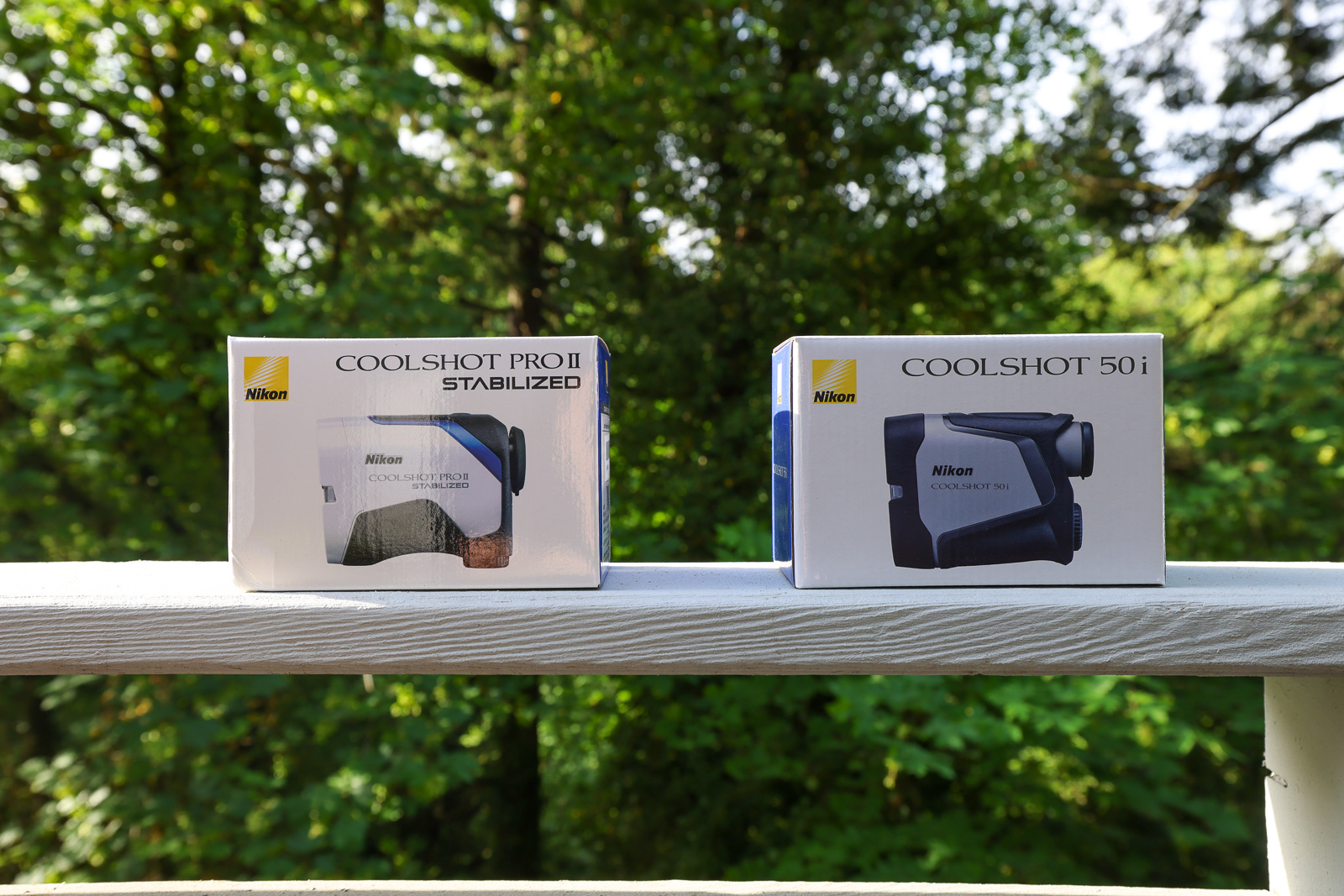
You know that feeling you get when you open up, say, an Apple product for the first time? It just feels special.
With the Nikon rangefinders, while the packaging is fine, it’s clear this wasn’t their priority with the rangefinder.
And that’s ok with me. I’d rather have them put all of that energy into the device itself than with frivolous packaging.
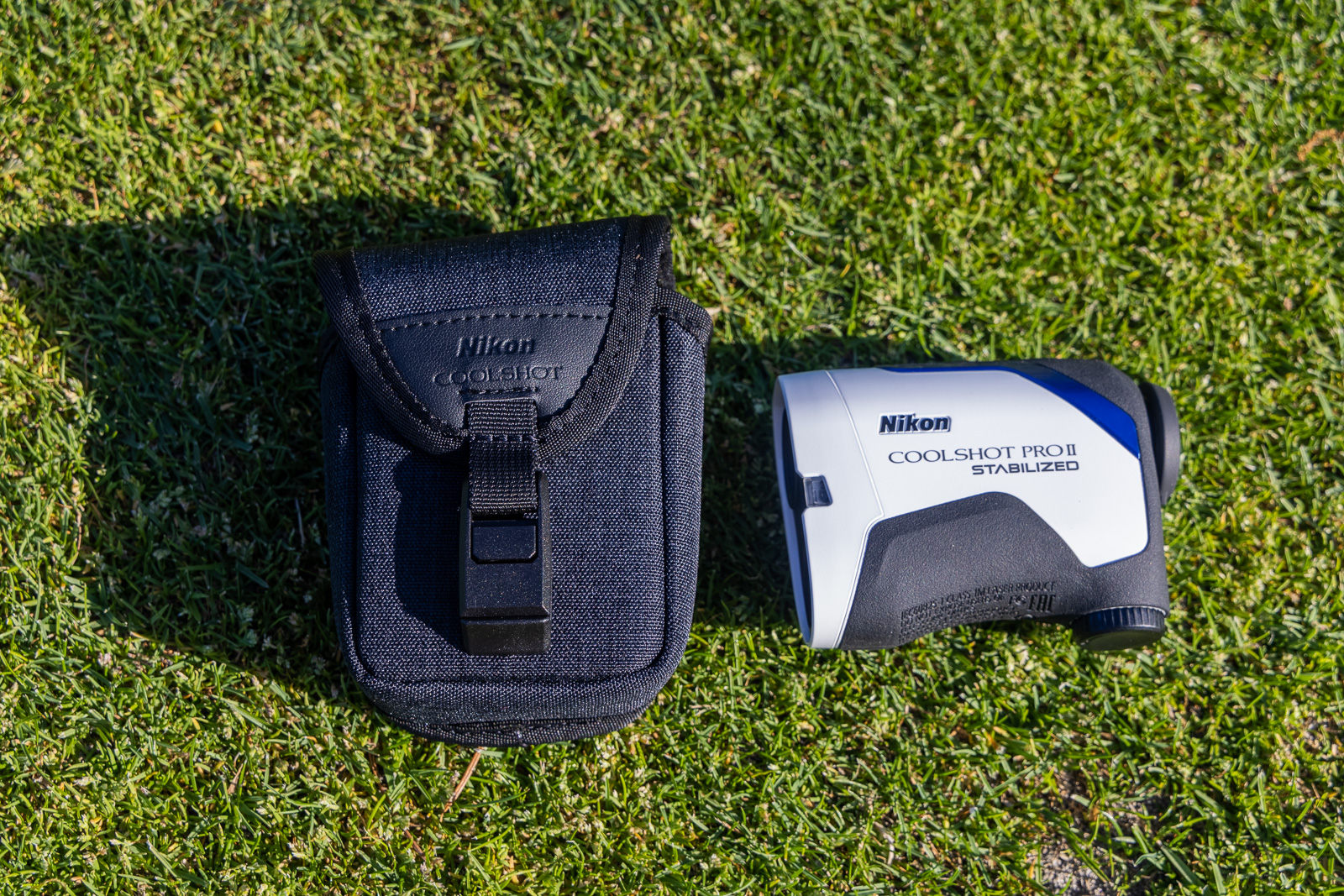
In the box you have everything you’d expect:
- The rangefinder
- A canvas carrying case
- A battery
- A lens brush
- Instructions/warranty card
The very first thing I noticed is that it’s much smaller than the Bushnell Pro XE. By this, I don’t mean that it’s small, it’s average-sized. The Pro XE just happens to be the largest rangefinder I’ve tested.
It feels great in your hands, and the ergonomics are very nice.
Putting the battery in was a breeze, which can be weirdly cumbersome with some devices.
There’s some very high-quality rubber on it, but the plastic does feel a little bit cheaper when compared to other high-end rangefinders. That said, it’s waterproof, so no need to stress on that next Bandon trip.
There are two buttons on top: the power button and a mode button.
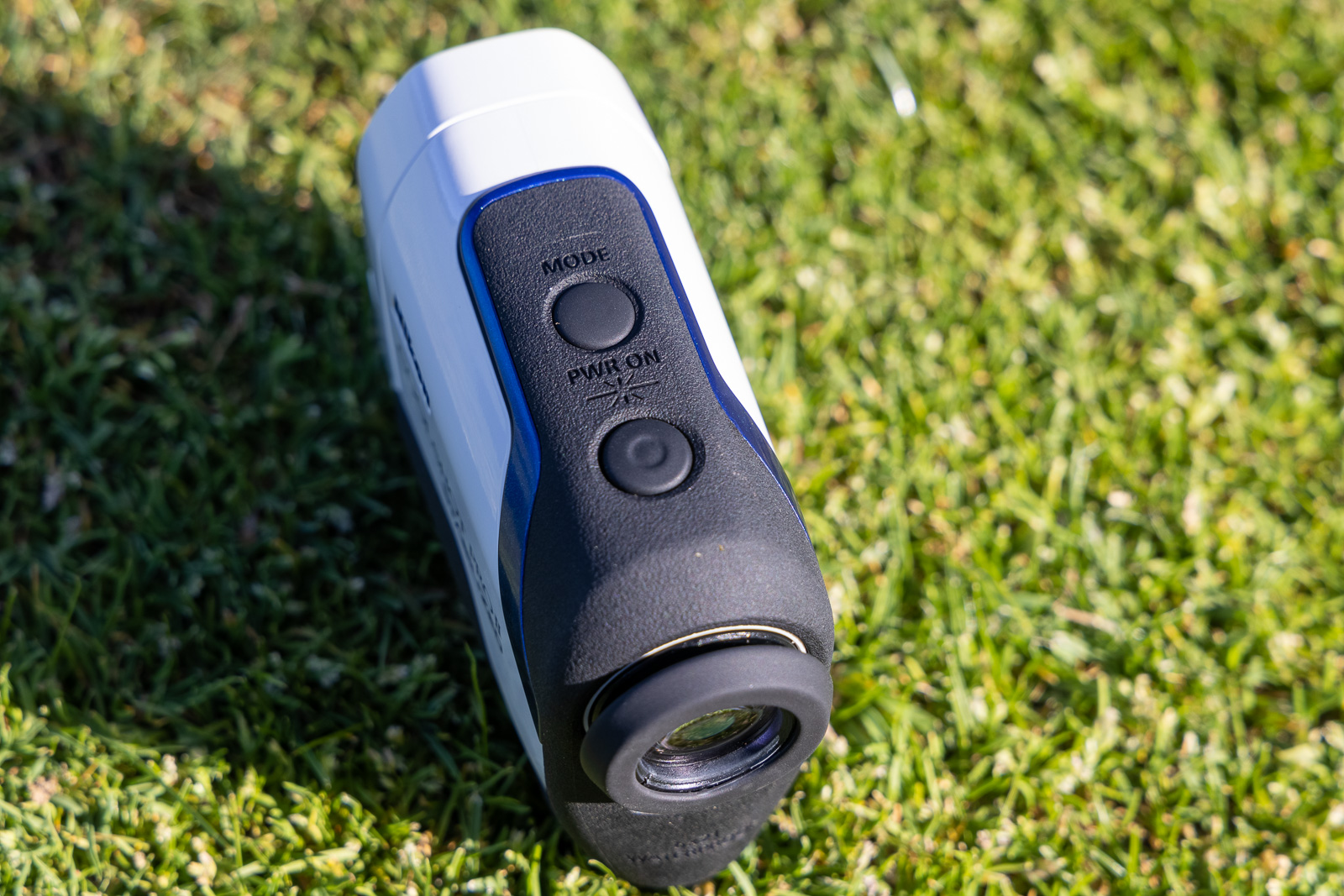
The power button is what you use to get your distances, and the mode button switches between the 4 different laser modes included in the device.
The modes are:
- Golf Mode: Slope adjusted distance (horizontal distance +/- height) and actual distance
- Actual distance mode
- Actual distance and height mode
- Horizontal distance and height mode
When it comes to different modes with golf rangefinders I feel like manufacturers need to be careful. If you have too many of them, it can get confusing at times to actually know what mode you’re in, and what each one specifically does. I ran into this with the Bluetees rangefinders, where there was one mode I accidentally found myself in occasionally, and I still don’t really know what it does.
This is also why I think the Bushnell V5 without slope is such a killer product.
There’s a little bit of this happening in the Nikon Rangefinder as well.
There are two golf modes: slope and non-slope, and then two more modes that I honestly just had to look up to see what they did.
It’s easy to accidentally press the mode button to switch between them, so occasionally you’ll find yourself in a different mode than you expect.
This isn’t an issue after you get familiar with the device, but you might find yourself playing with it for the first few holes to learn where you need to be
The Best Optical Quality I’ve Ever Seen in a Golf Rangefinder
Within seconds of using this rangefinder for the first time, you can feel the quality.
Many lesser rangefinder brands will add all the features in the world to their devices, but they can often miss big things like: optical quality, screen quality, ergonomics, and accuracy.
Who cares about having a vibrating slope mode, if you can barely see the target through low-quality glass.
I don’t make this statement lightly: this Nikon rangefinder has the best optics of any rangefinder I’ve ever used.
From the moment you first look through the viewfinder, you’re impressed.
The image is crystal clear and it’s very easy to adjust focus using the ring around the viewfinder.
One of the things that has always set Bushnell apart from competitors is its screen quality. The numbers are bright, clear, and located in a good spot.
The OLED screen inside the Nikon Rangefinder is even better. It’s extremely sharp and very impressive.
To take things a step further, it’s dual-colored. All of your distances light up in red, but when you lock onto the flag, you get a green ring around the screen to confirm you’ve found the flag.
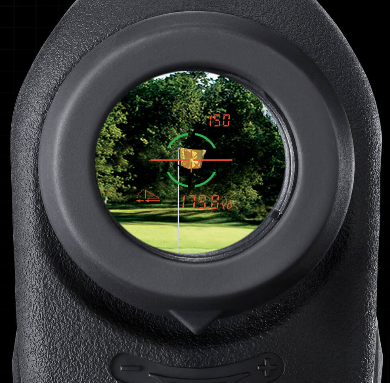
It works really well, and it’s nice to see a device pay such close attention to the quality of the screen and the glass. It truly makes a difference in usability.
The Nikon’s Unique Set of Features
Over the last couple of years, we’ve started to see the same set of features released on rangefinders:
- Slope
- Vibration technology
- Magnet
Nikon is bucking the trend here, and doing things a bit differently.
While it does have slope, it forgoes the vibration and magnet in favor of a few unique features that I haven’t seen on many devices.
Nikon “Echo Technology”
Let’s first start with vibration. All the companies have their own name for it, but basically, the device will vibrate to confirm you’re locked onto the flag.
On this Nikon Coolshot, they have what they call “Echo” technology. Instead of a vibration, you get the green ring on the screen that I mentioned before, and an audible little chirp (which can be turned off).
I expected to really miss the vibration, but I actually found that their “Echo” feature worked really well, and provided nearly the same experience.
Stabilization in a Rangefinder?
Another feature that is unique to this device is stabilization. Similar to how a high-end camera might have in-body stabilization to reduce shake when taking a photo, this stabilizes to make it easier to lock onto the flag.
And it works too.
If you’re looking at the flagstick and you slow down your panning to try and lock on, you can visually see the image lock closer into place to make it easier to get a reading.
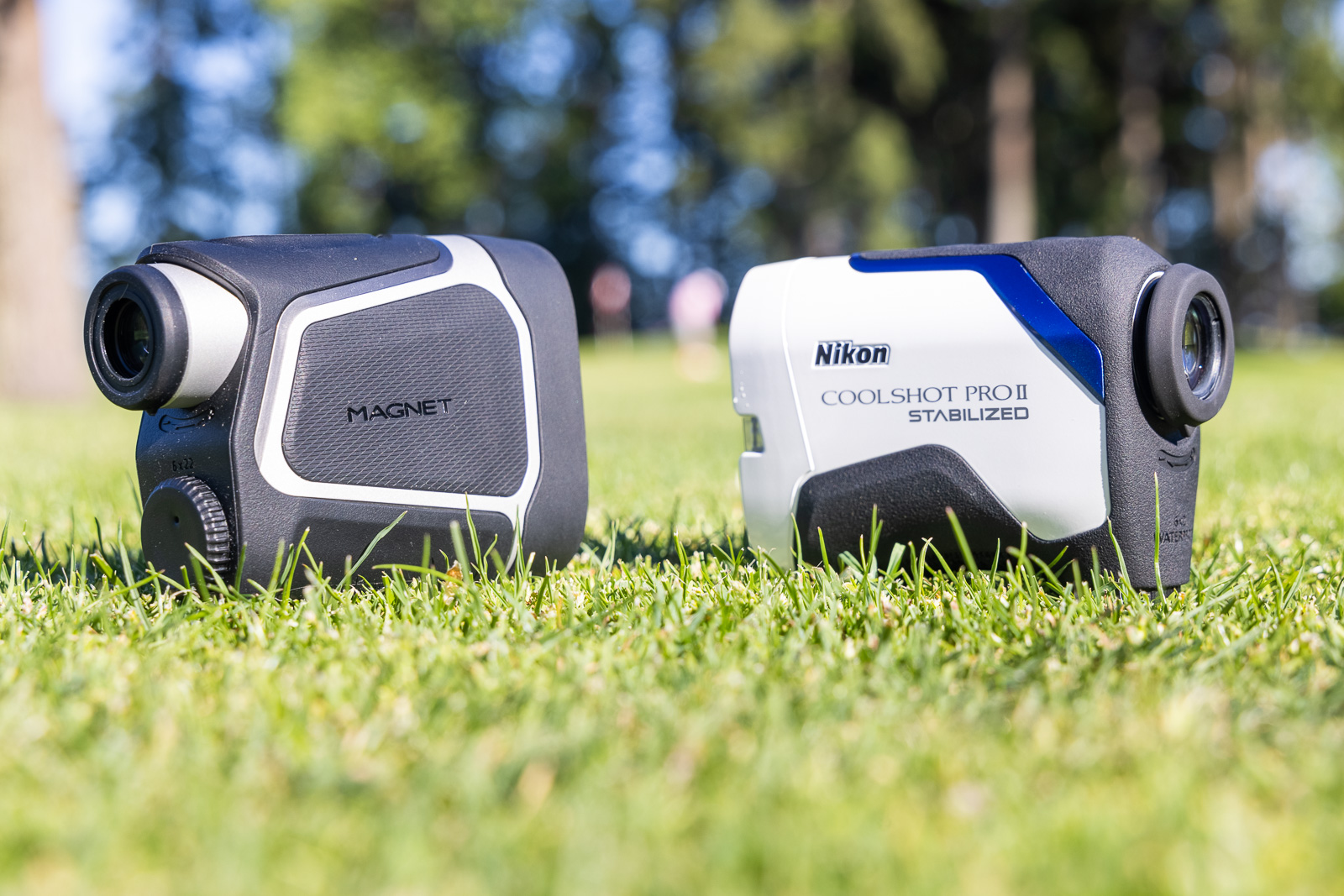
Overall it was a really helpful feature, and if you’re someone who often struggles to get a flag reading due to shaky hands, this is a game-changer.
Occasionally it will overcompensate and you’ll see it jump a little bit, but this didn’t happen very often, and the technology was a welcome inclusion in a rangefinder.
Built for Competition
One of my favorite features that was introduced on the Bushnell X2 was having a toggle on the outside of the device to switch between slope/non-slope modes for competition use. At first, I didn’t see anything like this on the Nikon ProII rangefinder.
That is until I released that if you put it in non-slope mode, a green light will light up on the front of the device to indicate you’re ok for competition.
The Nikon Coolshot ProII isn’t necessarily a flashy device, but the more I used it, the more I found cool features like the ones I listed above.
Clearly, a lot of thought went into this device, and it shows.
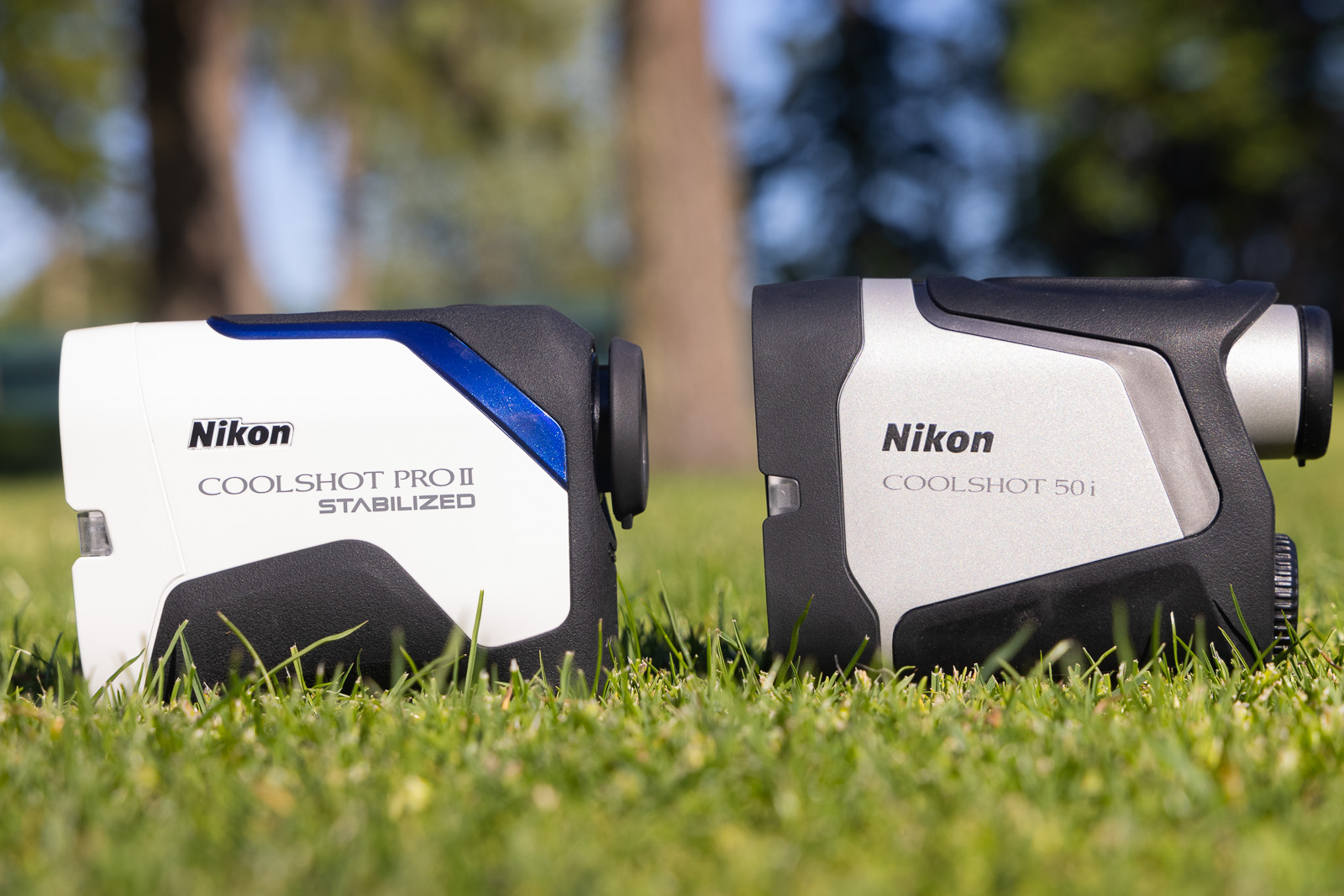
Nikon Coolshot ProII Stabilized Performance
So when you combine all of this together, how does it actually perform?
Good. Very good.
This is one of the fastest and most accurate rangefinders I’ve ever used.
I was able to get precise distances, and the “echo” technology let me be very confident that I was getting the right distances. I hardly ever had issues with it back-focusing and missing the pin for the trees behind the hole.
Its accuracy is rated at +/- .75 yards for anything less than 700 yards.
Not that you usually need to, but I was able to get pinpoint accurate readings over 400 yards from the teebox on a few par 4s. I got these quickly, and without trying to hunt to get it to lock on.
As I mentioned above, the stabilization was super helpful, and clearly, an area where Nikon has a competitive advantage having honed the tech in their cameras and lenses.
A minor complaint I have is that I found it occasionally difficult to look through the viewfinder.
You know if you have a pair of binoculars or a telescope, sometimes it can take a second to lineup your eyes with the lenses before you can see through it – I had the occasional issue with that here.
I figured it out after my first round with it, but it did seem a bit more difficult to focus in on than with other devices.
But once you did? Crystal clear.
Another minor complaint is when you’re in golf mode, it gives you the actual distance on the top right of the screen, and the slope adjusted distance front and center.
I personally prefer to have the actual distance more prominent and would have liked those switched. This layout array is one area where I prefer to way the Pro XE does it, but the Nikon is superior to most other rangefinder brands I’ve reviewed in this regard.
Let’s Summarize: My Honest Thoughts
Honestly, Nikon faces an uphill battle going up against Bushnell. If for no other reason than marketing. For instance, did you even know Nikon made a golf rangefinder?
Bushnell has excellent products at the price points Nikon is going after, but this device may be the one to actually put a dent in their market share.
The build quality doesn’t feel quite as substantial as the Bushnell devices. But being waterproof and using high-quality materials, it probably is, it just doesn’t quite feel like it to me.
Some people will miss the magnet that you find on the Pro X3, the V5, the NX9, and even their own lower-priced Coolshot 50i.
Others will miss the vibration.
There will be people who opt for the Precision Pro NX9 or Precision Pro NX10 with all of that, at a fraction of the price.
The Nikon ProII Stabilized isn’t for those people.
This is one of the best rangefinders I’ve ever used, but it’s taken me a little bit to wrap my head around it, just because it presents things in a slightly different way than what most rangefinder companies are doing.
Right now Nikon isn’t the “cool” choice. But they’ve created something here that in many ways exceeds what we’re seeing from other manufacturers while falling a bit short in other areas.
If you’re someone who has struggled to get a rangefinder to actually lock onto the flag? The stabilized image here will be perfect for you.
Do you want the best image and screen you’ll find in a rangefinder? This is for you.
If you’re a more visual or auditory person, you’ll love the echo tech.
Are you ok with not having the device that everyone else in your club or on Instagram has? Then this is fantastic.
At $449, the Nikon Coolshot ProII Stabilized is not cheap. On paper, you might see other devices with “more” features for half the price.
Don’t be fooled. While some of those are very good, optics, screen quality, speed, and accuracy are paramount with a rangefinder: and this is about as good as it gets.
Is it better than the V5 or the Pro XE? Not necessarily for everyone, but for some of you? It will absolutely be a better fit.
Is this not the right one for you? Check out our list of the best golf rangefinders currently available.
Nikon is known for world class camera lenses, so it's only natural their rangefinder will look crystal clear. Throw in image stabilization? And you have a very unique golf rangefinder that works great.
This page contains affiliate links. This means that if you click a link and buy one of the products on this page, I may receive a commission (at no extra cost to you!) This doesn’t affect our opinions or our reviews. Everything we do is to benefit you as the reader, so all of our reviews are as honest and unbiased as possible.
Years after it's release, still the gold standard for an image-stabilized rangefinder
The Nikon Coolshot Pro II Stabilized occupies a unique space in the golf rangefinder market. Is has some of the best optics around and along with the Leupold GX-6C has the best image stabilization you'll find. So if you have shaky hands? This is the one for you.
The Good
- Wonderful optics
- Excellent image stabilization
The Bad
- Doesnt feel as high end as some others
- Modes can be confusing at first
-
Presentation
-
Performance
-
Price
-
Personal Affinity

